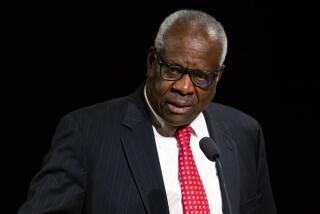Navigating the Rough Waters of Libel
“A jury says Time magazine published false and defamatory statements about then-Israeli Defense Minister Ariel Sharon, that a Time reporter was careless and negligent, but Time wins the libel suit filed by Sharon. I’m confused. Would you please explain libel law so I can understand the court’s ruling?”
This question, recently posed by a newspaper advertising executive, has been repeatedly asked in one form or another by readers who don’t understand how Time could be wrong but still be right in the eyes of the law.
To eliminate some of the confusion, here is a short and simplified layman’s lesson in the law of defamation, the law that protects your reputation in the community.
Defamation is the legal name for the offense of injuring a person’s reputation by false oral or written statements. It is called libel when the statements are in written form, slander when the statements are oral.
False Gossip
In other words, if you whisper to your neighbor over the fence that your gardener stole your car--but he didn’t--you’ve slandered the gardener. If your neighbor then passes on this false gossip about the gardener in a letter to a friend, it would be libel.
In this column, we’ll focus on libel and the press. Twenty years ago, the law of libel was much easier to understand. To repair your injured reputation and win money damages, basically, all you had to do--whether you were President of the United States or Joe Doakes--was convince a court that something written about you was false and that it injured your reputation. Each state had its own law of libel. The federal government wasn’t involved, and the U.S. Constitution didn’t seem to apply.
Then, in 1964, the rules for libel suits against the media were changed when the United States Supreme Court issued a ruling in a case brought against the New York Times by a Montgomery, Ala., police commissioner, L. B. Sullivan.
Sullivan was awarded $500,000 by an Alabama state court for damage to his reputation stemming from an advertisement in the New York Times, placed by civil rights leaders, which contained some relatively minor inaccuracies about police reaction to a civil rights demonstration.
The Supreme Court decided that Sullivan had to prove a whole lot more than falsity to win his case. The court created a new rule of law. Sullivan had to prove something the court called “actual malice.”
It was a poor choice of words, and it has confused some judges, lawyers, journalists and juries ever since. You don’t have to prove ill will or evil intent, the common meaning of the word malice. The court used the words actual malice to describe something entirely different, a new legal standard meant to protect freedom of the press.
Actual Malice
You prove actual malice when you show that someone published false and injurious statements about you, but knew the statements were false--in other words, an intentional lie--or that the person showed reckless disregard for the truth. To prove reckless disregard, it is not enough to show that the publisher should have known or that a reasonable person would have known that the statements were false if he’d done a bit more checking. You must show that the publisher actually “entertained serious doubts” about the truth of the statements and went ahead and published them anyway.
In addition, the court said, you have to meet this actual-malice standard by proving it with “clear and convincing evidence,” a higher legal hurdle than proving something by a “preponderence of the evidence” as required in most civil proceedings.
The court derived this rule of law from the First Amendment to the U. S. Constitution, which protects freedom of speech and the press. These new protections were needed, the court concluded, to encourage wide-open, robust debate about government and public issues. The media must have some room to make unintentional mistakes. Otherwise, the court feared that libel suits by public officials would “chill” or inhibit the press from reporting about government activities.
The court said that erroneous statements are “inevitable in free debate, and . . . must be protected if the freedoms of expression are to have the breathing space that they need . . . to survive.”
Public officials, the court reasoned, have access to the public to respond to statements made about them, “to contradict the lie or correct the error.” There was also a sense that public officials, when they seek office and become involved in controversial issues, assume the risk that they will be criticized and that the criticism may include unintentional errors.
It is still not entirely clear whether actual malice must be shown when non-media defendants are sued by public officials for libel. That issue will be decided this year in a case now pending before the Supreme Court.
In decisions following the Sullivan case, the Supreme Court applied these same tough actual-malice standards to public figures, those who thrust themselves into public controversy, even though they don’t hold public office.
Private persons also have a greater burden than under the old non-constitutional law. At a minimum, they must prove that the publisher of the false statements was negligent, that is, sloppy or careless.
In other words, if Ariel Sharon had been a private person, not a public figure, he would have won because the jury did decide that Time was careless and negligent. But Sharon lost because he was unable to convince the jury that Time or its staff knew its stories were false or recklessly disregarded whether they were true.
Many readers, when they heard that Time won because Sharon was unable to prove malice, incorrectly understood malice to mean the ordinary kind--spite or ill will. But they weren’t alone. Many lawyers don’t understand the difference between malice as defined by Webster’s and actual malice as defined by the highest court, so it’s no wonder that non-lawyers are confused.
Fortunately for the jurors in the libel suit filed against CBS by General William C. Westmoreland, they will be spared the trauma of trying to apply this legal standard. Earlier this week, Westmoreland dismissed his suit. Perhaps, after weeks of testimony and millions of dollars in legal fees, the parties accepted the rationale of the Supreme Court in the Sullivan case--complaints by public officials about press coverage are better left resolved in the court of public opinion than in a court of law.
Legal Brief
Many readers have written in response to my column about powers of attorney--asking where to buy the form for a durable power of attorney for health care (the concept of durable power of attorney was explained in the Legal View column that ran Jan. 24). It seems that they are not available in many stationery stores. A representative of Wolcott’s, a Los Angeles-based stationery and legal-form publishing company, tells me that a new form just came hot off the presses recently. It’s available from Wolcott’s, 214 S. Spring St., and should be available soon at stationery stores throughout the state.
More to Read
Sign up for Essential California
The most important California stories and recommendations in your inbox every morning.
You may occasionally receive promotional content from the Los Angeles Times.









